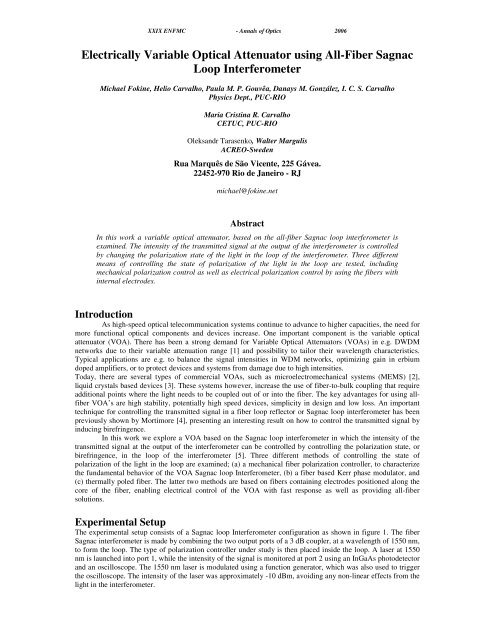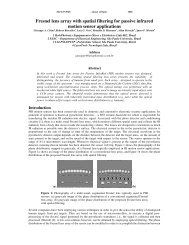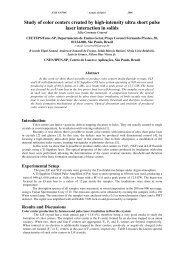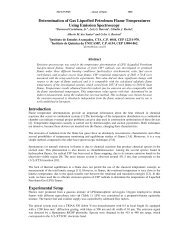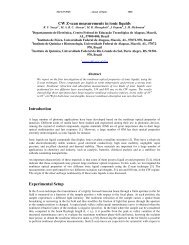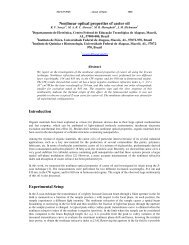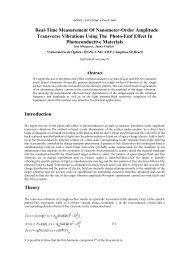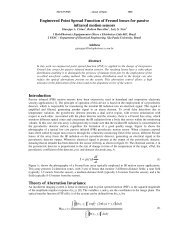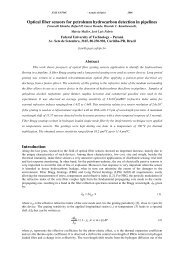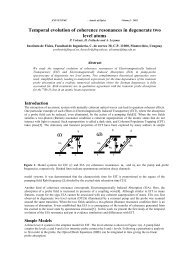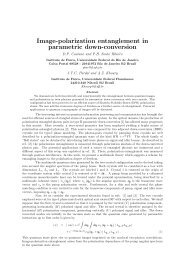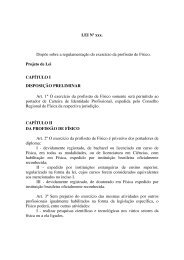Electrically Variable Optical Attenuator using All-Fiber Sagnac Loop ...
Electrically Variable Optical Attenuator using All-Fiber Sagnac Loop ...
Electrically Variable Optical Attenuator using All-Fiber Sagnac Loop ...
You also want an ePaper? Increase the reach of your titles
YUMPU automatically turns print PDFs into web optimized ePapers that Google loves.
XXIX ENFMC - Annals of Optics 2006<br />
<strong>Electrically</strong> <strong>Variable</strong> <strong>Optical</strong> <strong>Attenuator</strong> <strong>using</strong> <strong>All</strong>-<strong>Fiber</strong> <strong>Sagnac</strong><br />
<strong>Loop</strong> Interferometer<br />
Michael Fokine, Helio Carvalho, Paula M. P. Gouvêa, Danays M. González, I. C. S. Carvalho<br />
Physics Dept., PUC-RIO<br />
Maria Cristina R. Carvalho<br />
CETUC, PUC-RIO<br />
Oleksandr Tarasenko, Walter Margulis<br />
ACREO-Sweden<br />
Rua Marquês de São Vicente, 225 Gávea.<br />
22452-970 Rio de Janeiro - RJ<br />
michael@fokine.net<br />
Abstract<br />
In this work a variable optical attenuator, based on the all-fiber <strong>Sagnac</strong> loop interferometer is<br />
examined. The intensity of the transmitted signal at the output of the interferometer is controlled<br />
by changing the polarization state of the light in the loop of the interferometer. Three different<br />
means of controlling the state of polarization of the light in the loop are tested, including<br />
mechanical polarization control as well as electrical polarization control by <strong>using</strong> the fibers with<br />
internal electrodes.<br />
Introduction<br />
As high-speed optical telecommunication systems continue to advance to higher capacities, the need for<br />
more functional optical components and devices increase. One important component is the variable optical<br />
attenuator (VOA). There has been a strong demand for <strong>Variable</strong> <strong>Optical</strong> <strong>Attenuator</strong>s (VOAs) in e.g. DWDM<br />
networks due to their variable attenuation range [1] and possibility to tailor their wavelength characteristics.<br />
Typical applications are e.g. to balance the signal intensities in WDM networks, optimizing gain in erbium<br />
doped amplifiers, or to protect devices and systems from damage due to high intensities.<br />
Today, there are several types of commercial VOAs, such as microelectromechanical systems (MEMS) [2],<br />
liquid crystals based devices [3]. These systems however, increase the use of fiber-to-bulk coupling that require<br />
additional points where the light needs to be coupled out of or into the fiber. The key advantages for <strong>using</strong> allfiber<br />
VOA’s are high stability, potentially high speed devices, simplicity in design and low loss. An important<br />
technique for controlling the transmitted signal in a fiber loop reflector or <strong>Sagnac</strong> loop interferometer has been<br />
previously shown by Mortimore [4], presenting an interesting result on how to control the transmitted signal by<br />
inducing birefringence.<br />
In this work we explore a VOA based on the <strong>Sagnac</strong> loop interferometer in which the intensity of the<br />
transmitted signal at the output of the interferometer can be controlled by controlling the polarization state, or<br />
birefringence, in the loop of the interferometer [5]. Three different methods of controlling the state of<br />
polarization of the light in the loop are examined; (a) a mechanical fiber polarization controller, to characterize<br />
the fundamental behavior of the VOA <strong>Sagnac</strong> loop Interferometer, (b) a fiber based Kerr phase modulator, and<br />
(c) thermally poled fiber. The latter two methods are based on fibers containing electrodes positioned along the<br />
core of the fiber, enabling electrical control of the VOA with fast response as well as providing all-fiber<br />
solutions.<br />
Experimental Setup<br />
The experimental setup consists of a <strong>Sagnac</strong> loop Interferometer configuration as shown in figure 1. The fiber<br />
<strong>Sagnac</strong> interferometer is made by combining the two output ports of a 3 dB coupler, at a wavelength of 1550 nm,<br />
to form the loop. The type of polarization controller under study is then placed inside the loop. A laser at 1550<br />
nm is launched into port 1, while the intensity of the signal is monitored at port 2 <strong>using</strong> an InGaAs photodetector<br />
and an oscilloscope. The 1550 nm laser is modulated <strong>using</strong> a function generator, which was also used to trigger<br />
the oscilloscope. The intensity of the laser was approximately -10 dBm, avoiding any non-linear effects from the<br />
light in the interferometer.
XXIX ENFMC - Annals of Optics 2006<br />
The mechanical polarization controller was a Newport F-Pol-PC device. This device works on the principle of a<br />
mechanical fiber squeezer mechanism, which is rotated about the fiber. This allows conversion of any input<br />
polarization to any desired output polarization. The Kerr phase modulator and the poled fiber device are based<br />
on metal-electrode filled two-hole fibers. The metal electrodes are inserted into the holes of the fiber by a<br />
temperature-pressure process described in detail elsewhere [6]. For the Kerr phase modulator a low-temperature<br />
alloy of Bi-Sn was used and typical fiber-electrode lengths of 1-2 meters [7]. For the poled fiber device, either<br />
lead (Pb) or Au-Sn alloy was used. In this case the length of the fiber-electrode is much shorter, typically 10-15<br />
cm. Thermal poling of electrode containing fiber is described in detail by Myrén et. al. [8]<br />
Figure 1: Schematic diagram of <strong>Sagnac</strong> loop interferometer and experimental setup (MPC-<br />
Mechanical polarization controller, EPC-electric polarization controller)<br />
Results and Discussions<br />
Figure 1 shows the output response of the <strong>Sagnac</strong> loop interferometer as a function of the angular variation of the<br />
mechanical polarization controller at a set value of applied pressure to the fiber squeezer. The function of the<br />
rotation of the mechanical polarizer corresponds approximately to a corresponding rotation of a half wave plate,<br />
showing a maxima or minima every 45 degrees. As can be seen, the rotation of the mechanical polarizer results<br />
in very repeatable results with minima very close to zero, representing a signal extinction ratio of more than<br />
99%, indicating the potential as a wide dynamic range device. As for long term operation, this device shows very<br />
good stability, an intrinsic property of the <strong>Sagnac</strong> loop interferometer. Further, a comparison between the<br />
different means of polarization control will be presented including details on the overall electrical and optical<br />
performance of the different devices.<br />
Intensity (a.u.)<br />
2200<br />
2000<br />
1800<br />
1600<br />
1400<br />
1200<br />
1000<br />
800<br />
600<br />
400<br />
200<br />
0<br />
Measurement data<br />
Fitted (sin) data<br />
0 40 80 120 160 200 240 280<br />
Rotating angle (deg)<br />
Figure 2: Typical response of the output from the <strong>Sagnac</strong> loop interferometer when<br />
altering the polarization of the light in the loop <strong>using</strong> the mechanical polarization controller.
XXIX ENFMC - Annals of Optics 2006<br />
Conclusions<br />
<strong>Variable</strong> optical attenuators, based on the all-fiber <strong>Sagnac</strong> loop interferometer are examined. The intensity of the<br />
transmitted signal at the output of the interferometer is controlled by changing the polarization state of the light<br />
in the loop of the interferometer by <strong>using</strong> various methods of controlling the state of polarization of the light in<br />
the loop. The different methods include mechanical polarization control as well as electrical polarization control<br />
by <strong>using</strong> the fibers with internal electrodes.<br />
The rotation of the polarization based on the mechanical polarizer resulted in a reproducible, stable and wide<br />
dynamic device with an extinction ratio of more than 99%. The development of a VOA <strong>Sagnac</strong> loop<br />
Interferometer is further investigated when different means of polarization control are considered based on Kerr<br />
phase modulator and thermally poled fibers.<br />
Acknowledgements<br />
Michael Fokine acknowledges the financial support from CNPq<br />
References<br />
1. S. Cohen and P. Melman, “New breakthrough design for VOAs based on electro-optic materials,”<br />
Lightwave, January (2000).<br />
2. C. Chen, C. Lee, Y.-J. Lai, “Novel VOA Using In-Plane Reflective Micromirror and Off-Axis Light<br />
Attenuation,” IEEE <strong>Optical</strong> Communications 516-520 (2003).<br />
3. Y.-H. Wu, X. Liang, Y.-Q. Lu, F. Du, Y.-H. Lin, S.-T. Wu, “<strong>Variable</strong> optical attenuator with a polymerstabilized<br />
dual-frequency liquid crystal”, Appl. Opt., 44, 4394 (2005).<br />
4. D. B. Mortimore, <strong>Fiber</strong> <strong>Loop</strong> Reflectors, Journal of Lightwave Technology, 6, 1217 (1988).<br />
5. Valente, D. C. B., Costa, E. T. M., Gouvêa, P. M. P., Carvalho, I. C. S., Carvalgo, M. C. R., and Margulis,<br />
W., "A <strong>Sagnac</strong> Interferometer as a <strong>Variable</strong> <strong>Optical</strong> <strong>Attenuator</strong>", XXVI National Meeting of Condensed<br />
Matter Physics, p. 249, Caxambu, Brazil, May (2003).<br />
6. Fokine, M., Nilsson, L-E., Claesson, A., Berlemont, D., Kjellberg, L., Krummenacher, L., and Margulis, W.,<br />
"Integrated fiber Mach Zehnder interferometer for electro-optic switching", Optics Letters, 27 (18), p. 1643<br />
(2002).<br />
7. Fokine, M., Kjellberg, L., Helander, P., Myrén, N, Norin, L., Olsson, H., Sjödin, N., and Margulis, W., "A<br />
Fibre-Based Kerr Switch and Modulator"., 30th European Conference on <strong>Optical</strong> Communications<br />
(ECOC´2004)., Tu4.3.3, Stockholm, Sweden, Sept (2004).<br />
8. Myrén, N, Olsson, H., Norin, L., Sjödin, N., Helander, P., Svennebrink, J., and Margulis, W., "Wide wedgeshaped<br />
depletion region in thermally poled fiber with alloy electrodes", Optics Express, 12(25), 6093.<br />
(2004)


